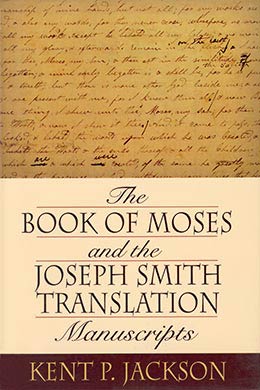An Appreciation
Kent P. Jackson, The Book of Moses and the Joseph Smith Translation Manuscripts (Provo, UT: Religious Studies Center, Brigham Young University, 2005), 173–174.
Concerning a time of persecution of the early Saints in June 1830, Joseph Smith’s history records: “Amid all the trials and tribulations we had to wade through, the Lord, who well knew our infantile and delicate situation, vouchsafed for us a supply of strength, and granted us ‘line upon line of knowledge—here a little and there a little,’ of which the following was a precious morsel.” [1] What was revealed is now known as Moses chapter 1, the beginning of the Book of Moses and the beginning also of the Joseph Smith Translation of the Bible.
Indeed Moses 1 is a “precious morsel,” and the same can be said for all of the Book of Moses. The Book of Moses plays a special role in the restoration of the fulness of the gospel. It may well be that it contains more distinctively Latter-day Saint doctrine than any other comparable section of scripture. Consider the following topics, in which profound truths, significant to our gospel understanding, are revealed: Man is indeed in the image of God (see Moses 6:9), and God speaks with His prophets as one man speaks with another—”face to face” (Moses 7:4). The Father’s work is without end, and His worlds are “without number” (Moses 1:33). In all of His creations, His work and glory consist of bringing to pass the immortality and eternal life of His children (see Moses 1:39; see also 1:33–39). Jesus Christ was with the Father in the beginning, He cast Satan out for rebellion in the premortal world (see Moses 4:2–3), and He was the Creator of this world as well as of all the Father’s innumerable worlds (see Moses 1:33). Jesus Christ is the only name given under heaven by which we can be saved (see Moses 6:52). Redemption is through His blood (see Moses 6:62), and animal sacrifice is in similitude of His sinless offering (see Moses 5:7). Satan stepped forward to take upon himself prerogatives that were not his, rebelling against God and Christ and seeking for himself God’s honor, power, and glory. His desire is to destroy our agency and lead us into bondage (see Moses 4:1–4). The fall of our first parents, Adam and Eve, was a necessary part of humanity’s course and a blessing for us as individuals. Had they not fallen, they would not have had children, they never would have known good and evil and the joy of redemption, and neither they nor we would ever have an opportunity for eternal life (see Moses 5:10–11). The gospel of Jesus Christ was revealed in the beginning; Adam was a Christian and was baptized in Jesus’s name (see Moses 6:51–62, 64–66), Adam and Eve taught the gospel to their children (see Moses 5:9–12), and their descendants believed in Christ, worshiped the Father in His name, and knew and understood the principles and ordinances of the gospel (see Moses 7:10–11; 8:23–24). Moses knew Christ as his Creator and Redeemer (see Moses 1:6, 32–33; 4:1–3), and Enoch established a community of Saints, walked with God, and was translated (see Moses 7:21, 27, 69).
Many of these teachings are found nowhere else in scripture, even in other books of modern revelation. These and other remarkable doctrinal contributions set the Book of Moses apart as a “precious morsel” without peer. It is one of the great treasures of the Restoration and a blessing of inestimable worth to the Church. It is my view that it is also an incontrovertible witness to the calling of Joseph Smith, because no mortal could have produced a work of such profound inspiration, scope, and vision. Whether in handwriting on its original manuscripts or in print in today’s modern edition, its truths come forward one after another to bear testimony of the universal scope of Christ’s gospel, the redemptive power of His mission, and the divine calling of the Prophet Joseph Smith, who brought this precious record forth.
Notes
[1] Joseph Smith, History of the Church of Jesus Christ of Latter-day Saints, ed. B. H. Roberts, 2nd ed. rev. (Salt Lake City: Deseret Book, 1957), 1:98.
